oil temperature Hyundai Equus 2014 Owner's Manual
[x] Cancel search | Manufacturer: HYUNDAI, Model Year: 2014, Model line: Equus, Model: Hyundai Equus 2014Pages: 479, PDF Size: 10.15 MB
Page 244 of 479
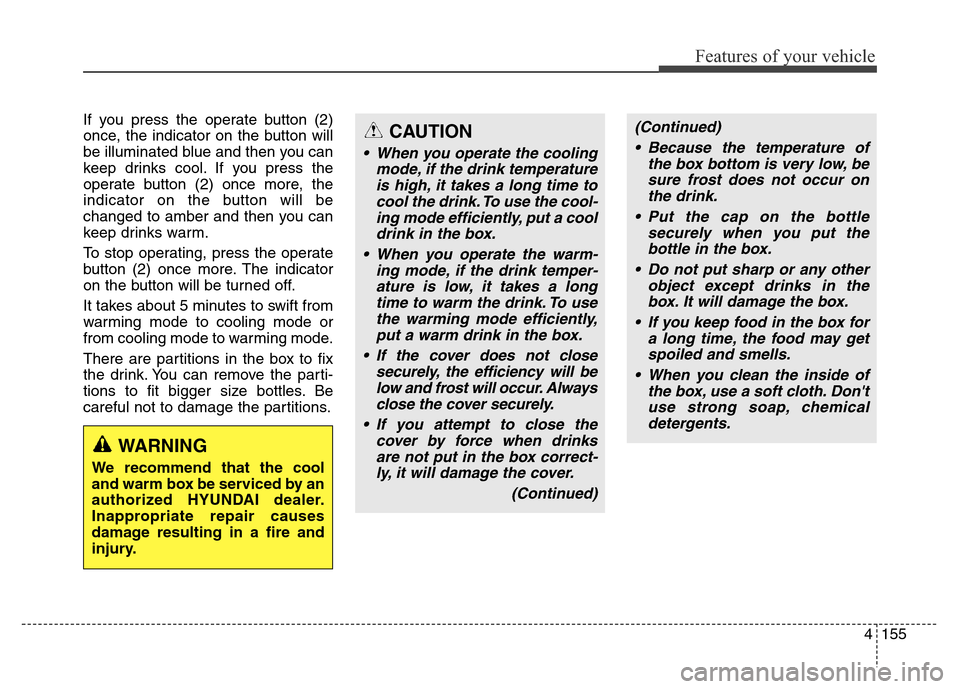
4155
Features of your vehicle
If you press the operate button (2)
once, the indicator on the button will
be illuminated blue and then you can
keep drinks cool. If you press the
operate button (2) once more, the
indicator on the button will be
changed to amber and then you can
keep drinks warm.
To stop operating, press the operate
button (2) once more. The indicator
on the button will be turned off.
It takes about 5 minutes to swift from
warming mode to cooling mode or
from cooling mode to warming mode.
There are partitions in the box to fix
the drink. You can remove the parti-
tions to fit bigger size bottles. Be
careful not to damage the partitions.
WARNING
We recommend that the cool
and warm box be serviced by an
authorized HYUNDAI dealer.
Inappropriate repair causes
damage resulting in a fire and
injury.
CAUTION
• When you operate the cooling
mode, if the drink temperature
is high, it takes a long time to
cool the drink. To use the cool-
ing mode efficiently, put a cool
drink in the box.
• When you operate the warm-
ing mode, if the drink temper-
ature is low, it takes a long
time to warm the drink. To use
the warming mode efficiently,
put a warm drink in the box.
• If the cover does not close
securely, the efficiency will be
low and frost will occur. Always
close the cover securely.
• If you attempt to close the
cover by force when drinks
are not put in the box correct-
ly, it will damage the cover.
(Continued)
(Continued)
• Because the temperature of
the box bottom is very low, be
sure frost does not occur on
the drink.
• Put the cap on the bottle
securely when you put the
bottle in the box.
• Do not put sharp or any other
object except drinks in the
box. It will damage the box.
• If you keep food in the box for
a long time, the food may get
spoiled and smells.
• When you clean the inside of
the box, use a soft cloth. Don't
use strong soap, chemical
detergents.
Page 395 of 479
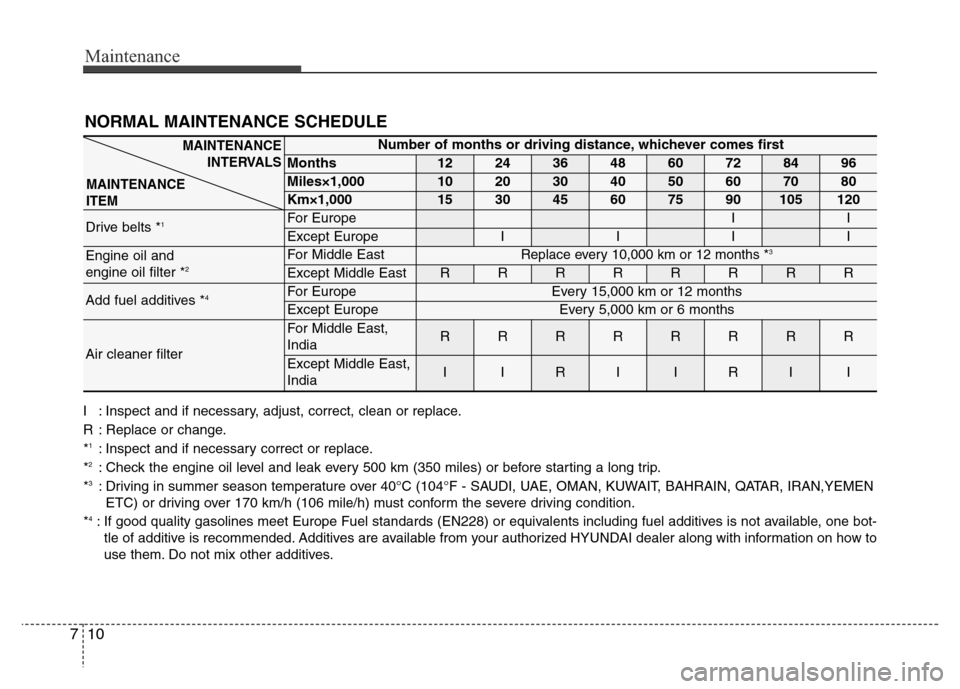
Maintenance
10 7
NORMAL MAINTENANCE SCHEDULE
I : Inspect and if necessary, adjust, correct, clean or replace.
R : Replace or change.
*
1: Inspect and if necessary correct or replace.
*2: Check the engine oil level and leak every 500 km (350 miles) or before starting a long trip.
*3: Driving in summer season temperature over 40°C (104°F - SAUDI, UAE, OMAN, KUWAIT, BAHRAIN, QATAR, IRAN,YEMEN
ETC) or driving over 170 km/h (106 mile/h) must conform the severe driving condition.
*
4: If good quality gasolines meet Europe Fuel standards (EN228) or equivalents including fuel additives is not available, one bot-
tle of additive is recommended. Additives are available from your authorized HYUNDAI dealer along with information on how to
use them. Do not mix other additives.
Number of months or driving distance, whichever comes first
Months1224364860728496
Miles×1,0001020304050607080
Km×1,000153045607590105120
Drive belts *1For EuropeII
Except EuropeIIII
Engine oil and
engine oil filter *2For Middle EastReplace every 10,000 km or 12 months *3
Except Middle EastRRRRRRRR
Add fuel additives *4For EuropeEvery 15,000 km or 12 months
Except EuropeEvery 5,000 km or 6 months
Air cleaner filter
For Middle East,
IndiaRRRRRRRR
Except Middle East,
IndiaIIRIIRII
MAINTENANCE
INTERVALS
MAINTENANCE
ITEM
Page 400 of 479
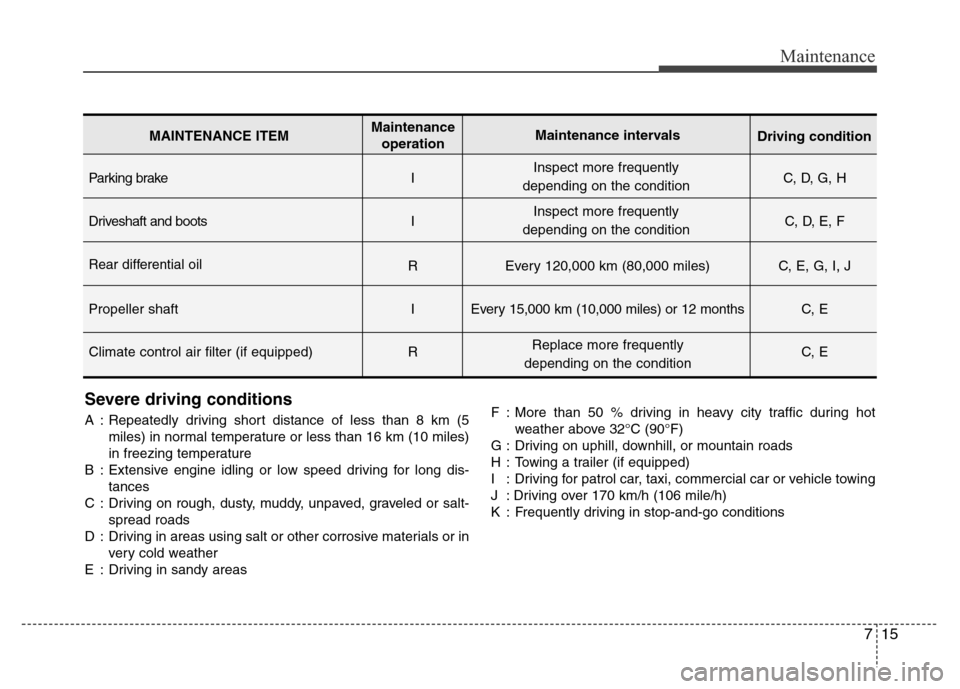
715
Maintenance
Parking brake I C, D, G, H
Driveshaft and boots I C, D, E, F
Rear differential oilR Every 120,000 km (80,000 miles) C, E, G, I, J
Propeller shaft I
Every 15,000 km (10,000 miles) or 12 monthsC, E
Climate control air filter (if equipped) R C, E
MAINTENANCE ITEMMaintenance
operationMaintenance intervals
Driving condition
Inspect more frequently
depending on the condition
Inspect more frequently
depending on the condition
Replace more frequently
depending on the condition
Severe driving conditions
A : Repeatedly driving short distance of less than 8 km (5
miles) in normal temperature or less than 16 km (10 miles)
in freezing temperature
B : Extensive engine idling or low speed driving for long dis-
tances
C : Driving on rough, dusty, muddy, unpaved, graveled or salt-
spread roads
D : Driving in areas using salt or other corrosive materials or in
very cold weather
E : Driving in sandy areasF : More than 50 % driving in heavy city traffic during hot
weather above 32°C (90°F)
G : Driving on uphill, downhill, or mountain roads
H : Towing a trailer (if equipped)
I : Driving for patrol car, taxi, commercial car or vehicle towing
J : Driving over 170 km/h (106 mile/h)
K : Frequently driving in stop-and-go conditions
Page 422 of 479
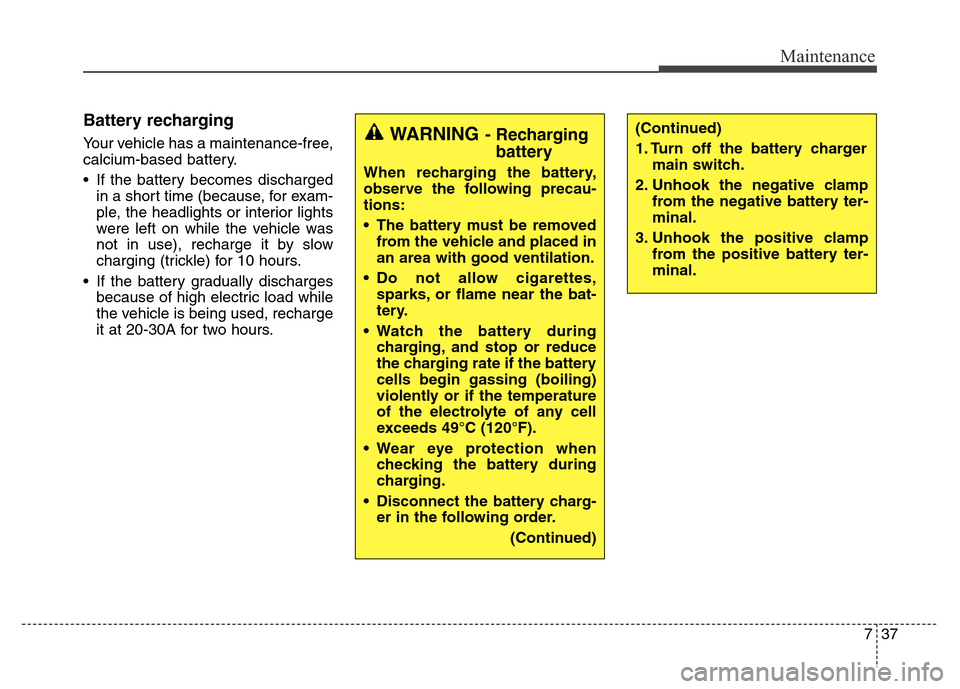
737
Maintenance
Battery recharging
Your vehicle has a maintenance-free,
calcium-based battery.
• If the battery becomes discharged
in a short time (because, for exam-
ple, the headlights or interior lights
were left on while the vehicle was
not in use), recharge it by slow
charging (trickle) for 10 hours.
• If the battery gradually discharges
because of high electric load while
the vehicle is being used, recharge
it at 20-30A for two hours.(Continued)
1. Turn off the battery charger
main switch.
2. Unhook the negative clamp
from the negative battery ter-
minal.
3. Unhook the positive clamp
from the positive battery ter-
minal.WARNING- Recharging
battery
When recharging the battery,
observe the following precau-
tions:
• The battery must be removed
from the vehicle and placed in
an area with good ventilation.
• Do not allow cigarettes,
sparks, or flame near the bat-
tery.
• Watch the battery during
charging, and stop or reduce
the charging rate if the battery
cells begin gassing (boiling)
violently or if the temperature
of the electrolyte of any cell
exceeds 49°C (120°F).
• Wear eye protection when
checking the battery during
charging.
• Disconnect the battery charg-
er in the following order.
(Continued)
Page 476 of 479
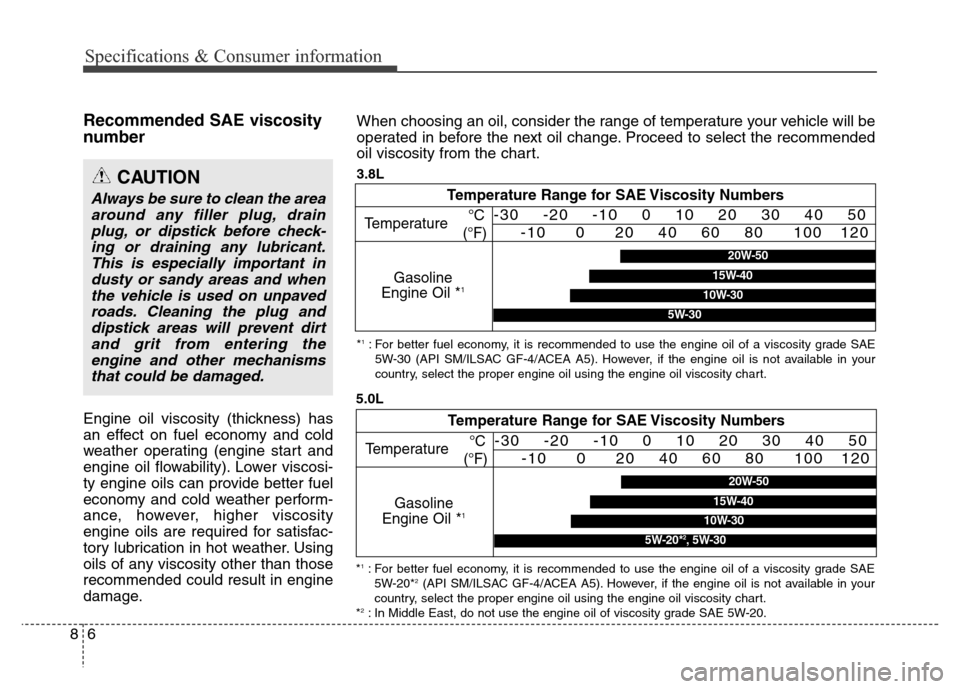
Specifications & Consumer information
6 8
Recommended SAE viscosity
number
Engine oil viscosity (thickness) has
an effect on fuel economy and cold
weather operating (engine start and
engine oil flowability). Lower viscosi-
ty engine oils can provide better fuel
economy and cold weather perform-
ance, however, higher viscosity
engine oils are required for satisfac-
tory lubrication in hot weather. Using
oils of any viscosity other than those
recommended could result in engine
damage.
CAUTION
Always be sure to clean the area
around any filler plug, drain
plug, or dipstick before check-
ing or draining any lubricant.
This is especially important in
dusty or sandy areas and when
the vehicle is used on unpaved
roads. Cleaning the plug and
dipstick areas will prevent dirt
and grit from entering the
engine and other mechanisms
that could be damaged.
When choosing an oil, consider the range of temperature your vehicle will be
operated in before the next oil change. Proceed to select the recommended
oil viscosity from the chart.
Temperature Range for SAE Viscosity Numbers
Temperature
Gasoline
Engine Oil *
1
°C
(°F)-30 -20 -10 0 10 20 30 40 50
-10 0 20 40 60 80 100 120
*1: For better fuel economy, it is recommended to use the engine oil of a viscosity grade SAE
5W-30 (API SM/ILSAC GF-4/ACEA A5). However, if the engine oil is not available in your
country, select the proper engine oil using the engine oil viscosity chart.
20W-50
10W-30
15W-40
5W-20*2, 5W-30
Temperature Range for SAE Viscosity Numbers
Temperature
Gasoline
Engine Oil *
1
°C
(°F)-30 -20 -10 0 10 20 30 40 50
-10 0 20 40 60 80 100 120
20W-50
10W-30
15W-40
5W-30
5.0L3.8L
*1: For better fuel economy, it is recommended to use the engine oil of a viscosity grade SAE
5W-20*2(API SM/ILSAC GF-4/ACEA A5). However, if the engine oil is not available in your
country, select the proper engine oil using the engine oil viscosity chart.
*
2: In Middle East, do not use the engine oil of viscosity grade SAE 5W-20.